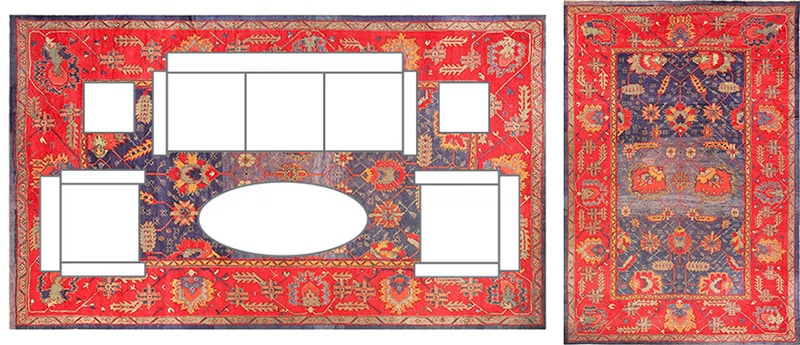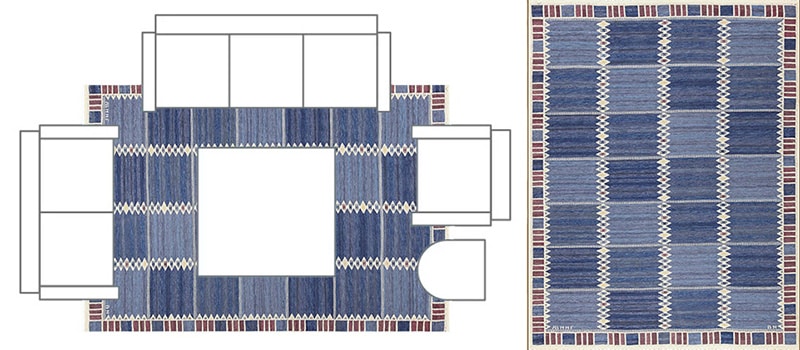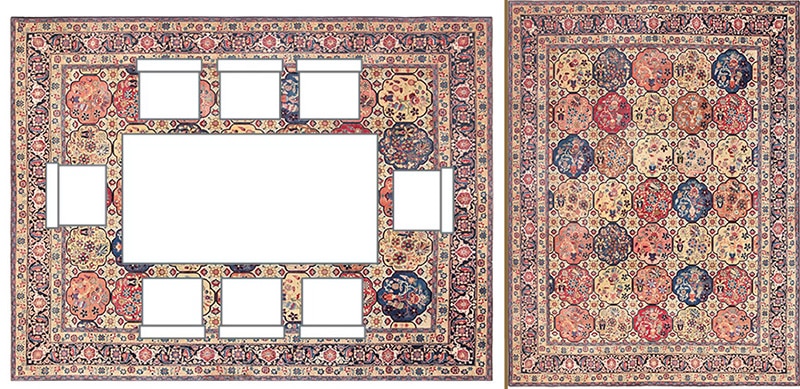The Best Way To Position and Place Rugs in Rooms
The ultimate rug placement guide
Many people automatically think that color or pattern is the most important factor to consider when buying rugs. In fact, the size of the rug as well as the the shape are equally important when trying to position and place it perfectly within the room and under the furniture. So try to envision your area rug placement in your room before you embark on your quest for attaining the perfect rug for your home.
In the article below we will focus placing antique carpets, modern area rugs and vintage rugs when buying area rugs for specific rooms in the home and: Choosing Dining Room Rugs | Choosing The Perfect Bedroom Rugs | Picking Living Room Rugs | Selecting Entryway Rugs For Your Foyer | Rugs for the Kitchen | Picking Your Family Room Rugs

How To Place Rugs In Rooms
Here Are Some Tips On How You Might Go About Placing Rugs In Different Rooms:
The first step is to select a rug depending on the the specific room you want to place it in. Once you have evaluated both the size and shape of your room, it is time to consider the furniture grouping in each space.
Consider using the rug placing and positioning options below to help you choose a layout:
Please note that when it comes to personal taste and preference, there is not wrong way to position a rug in a room. If you love it that means it is the perfect placement and the perfect rug for your specific decorating style. So please take our rug placement guide with a grain of salt as only you would know what the truly perfectly placed rug would be!
How To Place Rugs In Your Living Room:
The room’s shape, as well as your furniture, dictates your rug size, its shape as well as its orientation within the room’s layout. If you decide to have the sofa situated on the rug, be sure that it extends out a minimum of 6 inches on each side.
Position The Rug So That All The Legs Of The Couch Are Placed on the Rug

Living Room Layout With All The Sofa and Sid Tables Legs On The Rug
Placing all legs of the sofa on the rug requires an especially large size rug. This choice is best for floating furniture (as in – furniture that is not placed against a wall) or for anchoring a living room in an open concept space. Placing all pieces of furniture directly on the rug helps unify the different decorative pieces and make the seating area defined.
Position The Rug So That The Front Legs Of The Sofa Are On The Rug

Living Room Layout With Front Legs of The Couch and Tables Positioned On The Rug
This option is versatile, but it generally works best when one of the edges of the group of furniture is placed against a wall. Since consistency is essential for a cohesive look, the rug size should allow for the front legs of all pieces to rest on it while keeping all the back legs off the rug.
Position The Rug On Coffee Table Only

Living Room Layout With Rug Placed Just Under The Coffee Table
Since it plays off the scale of the room and tricks the mind into thinking the room is larger than it really is, placing a coffee table on small size rug is ideal for narrow or small spaces. To get the correct proportion, consider the interior measurements of your seating area. This will ensure the right amount of negative space is filled.
How To Place Rugs in Your Dining Room
Determining the proper area rug for a dining room depends on the size and shape of the dining table itself in addition the configuration of the actual room. Deciding on a rectangular vs a round shape rug should be an easy choice based on the room and table shape.
Position The Rug So That All The Dining Table and Chair Legs Are On The Rug
In terms of rug placement for dining rooms, it is clear-cut: place all legs of the table on the rug itself. The bigger rule of thumb is to make sure that the rug extends a minimum of 24 inches from the table legs. This should ensure that the dining room chairs will remain on the rug even when pushed back as people get up from from the table.
*If applicable, do not forget to take any extendable leaves into consideration. If you rarely open the table fully then most people will opt to chose a rug that will look good in the dining room as it is used most of the time.
Rectangular Rug Positioned Under A Rectangular Dining Room Table:

Rectangular Dining Room Table Layout With Rug Positioned Under The Table
Round Rug Positioned Under A Round Dining Room Table:

Round Dining Room Table Layout With A Round Rug Positioned Underneath
How To Place Rugs in Your Bedroom
Since the bed serves as the main focal point for the room, it also serves as the main factor for determining rug’s placement. In addition to further defining the space, a rug offers a soft and warmer spot for your feet to land on each morning.
It is also important to consider other features in the room and accompanying furniture such as nightstands, side tables, vanities or benches. However, furniture along other walls — such as dressers — do not generally need to be considered as factors.
Position The Rug So That It Is Completely Under The Bed

Bedroom Layout With Rug Positioned Under The Entire Bed and Night Stands
A general rule of thumb is to keep approximately 18 to 24 inches of space around the rug and avoid encroaching on any walkways.
Position The Rug So That 2 / 3 Of It Is Covered by The Bed

Bedroom Layout With Rug Positioned With Most of The Rug Under The Bed
This popular option still keeps 18 to 24 inches on all sides as well as some at the foot of the bed. To keep the look of the room symmetrical, consider an 8 x 10 room size rug for queen size beds and a 9 x 12 rug for king size ones.
Place Two Small Runners on Each Side Of The Bed:

Bedroom Layout With 2 Small Runner Rugs Positioned On Either Side Of The Bed
This flexible option works with all bed types and sizes. It is an especially excellent choice if both sides of your bed are situated against a wall. It is important to consider scale when contemplating this design. For the “optimal” look and feel, the two runners should not extend past the bed itself and should also be a touch wider than the nightstand.
We hope you enjoyed this how to guide to position and place rugs in rooms. If you have questions that were not covered in this post, please comment below.
How should area rugs be placed?
Placing area rugs requires careful consideration to ensure they enhance the overall aesthetics of a room.
Here are some guidelines on how to properly place area rugs:
- Size Matters:
- Choose a rug size that fits the seating area or the space you want to define.
- In living rooms, a common approach is to have the front legs of furniture on the rug. Alternatively, you can place all furniture completely on or off the rug, depending on the size.
- Furniture Arrangement:
- For living rooms, the rug should be large enough to encompass the main furniture grouping (sofas, chairs, coffee table).
- In dining rooms, ensure that the rug accommodates the table and chairs, even when they are pulled out for seating.
- Bedroom Placement:
- In bedrooms, consider placing a rug under the bed. Ideally, it should extend beyond the sides and foot of the bed to create a balanced look.
- Rug Shape:
- Choose a rug shape that complements the shape of the room and furniture. Rectangular rugs are versatile, while round rugs can work well under circular tables.
- Leave Space Around the Edges:
- Allow for a border of flooring around the edges of the rug. A common rule is to leave at least 8-24 inches of bare floor, depending on the room size.
- Hallways and Entryways:
- Use runners in hallways, ensuring they are centered and leave an equal amount of space on each side.
- In entryways, choose a rug that fits the space but doesn’t overwhelm it.
- Layering:
- Experiment with layering rugs for added interest. You can layer a smaller rug on top of a larger one or combine different textures and patterns.
- Consistent Style:
- Ensure that the style and pattern of the rug complement the overall decor of the room. It should enhance the visual appeal rather than clash with existing elements.
- Consider Traffic Flow:
- Place rugs in areas with high foot traffic to protect the flooring and create a comfortable walking surface.
- Rug Material:
- Choose the rug material based on the room’s function. Soft and plush rugs are suitable for bedrooms, while durable and easy-to-clean options work well in high-traffic areas.
- Personal Preference:
- Ultimately, trust your instincts and personal taste. Select a rug that you love and feel complements the room.
Remember that these guidelines are not strict rules, and personal preferences play a significant role in rug placement. Experiment with different arrangements to find what works best for your space and style.
What are the most important factors when placing rugs in rooms?
When placing rugs in rooms, several factors should be considered to achieve a balanced and aesthetically pleasing look.
Here are some important area rug placement factors to keep in mind:
- Room Size: Choose a rug size that complements the size of the room. A rug that is too small may make the room feel cramped, while a rug that is too large can overpower the space.
- Furniture Placement: Consider the layout of your furniture. Ideally, the front legs of sofas and chairs should be on the rug, creating a cohesive and unified seating area. This helps anchor the furniture arrangement.
- Rug Shape: The shape of the rug should complement the shape of the room. Rectangular rugs typically work well in most spaces, but round or square rugs can be used to define specific areas within a room.
- Style and Pattern: Choose a rug that complements the overall style of the room. If the room has bold patterns on furniture or walls, a more neutral rug might work best, and vice versa. Consider the color scheme as well.
- Traffic Flow: Place rugs in areas where there is high foot traffic to protect the flooring and provide a comfortable surface to walk on. In hallways, runners can help guide the flow of traffic.
- Layering: Experiment with layering rugs for added interest. This can involve placing a smaller rug on top of a larger one or combining different textures and patterns for a unique look.
- Rug Material: Consider the material of the rug based on the room’s function. For example, a soft, plush rug might be suitable for a bedroom, while a durable and easy-to-clean rug may be more appropriate for a dining or living room.
- Color Contrast: Use rugs to add contrast to the room. A rug with a different color or pattern can be a focal point that ties together various elements in the space.
- Maintenance: Consider the ease of cleaning and maintaining the rug. In high-traffic areas or rooms prone to spills, choose a rug that is easy to clean.
- Personal Preference: Ultimately, your personal taste and style should guide your rug choice. Choose a rug that you love and that enhances the overall aesthetic of the room.
By taking these factors into account, you can ensure that the placement of rugs in your rooms contributes to a harmonious and well-designed interior.
Generally speaking, do rugs go under couches or in front?
Both options—placing rugs under couches or in front of them—can work depending on the design preferences and layout of your room.
Here’s a breakdown of both approaches to placing a rug with a couch:
- Under Couch:
- Placing a rug under the couch is a common and classic choice. This method helps to anchor the seating area, creating a cohesive and unified look.
- For a living room, consider having the front legs of the sofa and chairs on the rug. This creates a sense of connection between the furniture pieces and defines the seating area.
- In Front of Couch:
- Another option is to place the rug in front of the couch, with the front legs of the furniture on the rug. This can work well in smaller spaces or when you want to showcase more of the rug’s design.
- It allows for a more layered and dynamic look, especially if you have hardwood or tile floors, as the rug defines a specific area within the room.
- Combination of Both:
- You can also combine both approaches by using a larger rug that extends under the entire seating area, with a smaller rug layered in front to add visual interest.
- This combination works particularly well if you have a large room and want to create distinct zones within the space.
- Consider Room Size:
- In larger rooms, a rug that extends beyond the couch can help tie the various elements together and prevent the space from feeling disconnected.
- In smaller rooms, a rug that fits the seating area can make the room feel cozy and well-defined.
- Personal Style:
- Your personal style and aesthetic preferences play a significant role. Some people prefer the classic look of a rug under the entire seating arrangement, while others may opt for a more eclectic and layered approach.
Ultimately, the decision depends on your room’s size, layout, and your personal taste. Experiment with different rug placements to see what visually works best in your space. Consider the size of the rug in relation to the furniture, the overall design of the room, and how you want the seating area to feel.
Does a rug have to be placed so that it is centered in a room?
While centering a rug in a room is a common practice, it is not a strict rule. The decision to center a rug depends on various factors, including the size of the room, the layout of furniture, and your design preferences.
Here are some considerations with regards to centering your area rugs in the room:
- Room Size:
- In larger rooms, centering a rug can help create a balanced and cohesive look. It allows the rug to anchor the entire space and provides a visual focal point.
- In smaller rooms, centering might not be necessary, especially if you want to leave more floor space visible to make the room feel larger.
- Furniture Layout:
- Consider the arrangement of furniture. If you have a central seating area, centering the rug under that area can help define the space.
- In some cases, you might choose to have furniture placed asymmetrically on the rug for a more eclectic or casual look.
- Rug Size:
- The size of the rug plays a crucial role. If you have a large rug that comfortably fits the entire seating area or dining table, centering becomes more natural.
- In cases where you have smaller rugs or runners, they might not cover the entire floor, and centering may not be as relevant.
- Focal Points:
- Consider the focal points in the room, such as a fireplace or a prominent piece of furniture. Centering the rug around these focal points can enhance the overall design.
- Symmetry vs. Asymmetry:
- If you prefer a more symmetrical look, centering the rug can contribute to a sense of order and balance.
- For a more eclectic or bohemian style, you might intentionally choose to offset the rug for a less structured appearance.
- Flooring Material:
- If you have hardwood or tile floors and want to showcase more of the flooring, you might choose to position the rug in a way that leaves some floor space visible around the edges.
While centering a rug is a traditional approach, it’s not a strict rule. The goal is to create a harmonious and visually appealing space. Consider the size of the room, the furniture layout, and your personal style when deciding how to position the rug within the room.
Should a rug go under all furniture?
Whether a rug should go under all furniture depends on various factors, including the room’s size, furniture layout, and design preferences.
Here are some considerations for placing rugs under furniture:
- Living Room:
- A common and classic approach is to have the front legs of sofas and chairs on the rug. This helps anchor the seating area and creates a cohesive look.
- If the rug is large enough, you can also consider having all furniture legs on the rug for a more unified appearance.
- Dining Room:
- In a dining room, the rug should be large enough to accommodate the dining table and chairs. Ensure that the rug extends beyond the chairs, even when they are pulled out.
- Bedroom:
- In a bedroom, place the rug under the bed, extending beyond the sides and foot of the bed. This creates a balanced and visually pleasing arrangement.
- Office or Study:
- When placing a rug in an office or study area, ensure that it is under the desk and chair, providing a comfortable and defined workspace.
- Entryway:
- In an entryway, consider placing a rug under a console table or bench to create a welcoming focal point. This also helps define the entry area.
- Consistent Approach:
- For a cohesive look, consider a consistent approach within a room. If you choose to have the front legs of furniture on the rug, maintain this arrangement for a harmonious design.
- Leave Some Legs Off:
- If the rug is smaller or if you want to showcase more of your flooring, it’s acceptable to have some furniture legs off the rug. This can create an airy and spacious feel.
- Balance and Proportion:
- Pay attention to the balance and proportion of the rug in relation to the furniture. A visually pleasing arrangement often involves a proportional placement of the rug.
- Consider Function:
- Think about the function of the space. In areas with high foot traffic, having the entire seating area on the rug can provide comfort and protection for the flooring.
- Personal Style:
- Ultimately, your personal style and preferences play a significant role. Choose a placement that aligns with your aesthetic and creates the desired visual impact.
The placement of a rug under furniture often involves having at least the front legs of sofas and chairs on the rug. However, variations can be made based on the size of the rug, the room’s function, and your personal style. Experiment with different placements to find what works best for your specific space.
How far should a rug be placed from the wall?
The distance between a rug and the wall depends on various factors, including the size of the room, the size of the rug, and the overall design aesthetic you want to achieve.
Here are some general guidelines for placing rugs inside a room and the distance from the walls:
- Living Room:
- In a living room, it’s common to leave a space of about 8 to 24 inches between the rug and the walls. This creates a border of exposed flooring and provides a visually appealing frame for the room.
- The size of the border may vary based on the room’s size and the size of the rug. In larger rooms, you can afford to have a wider border.
- Bedroom:
- In a bedroom, the rug should extend beyond the sides and foot of the bed. Leave a sufficient border around the rug to create a balanced and visually pleasing arrangement.
- Aim for a consistent space around the rug on all sides, if possible.
- Dining Room:
- In a dining room, the rug should extend beyond the dining table and chairs, even when the chairs are pulled out for seating. This ensures that the rug remains centered under the table.
- Leave a consistent space around the edges of the rug to maintain a cohesive look.
- Entryway:
- In an entryway, the rug should be centered and leave an equal amount of space around the edges. This helps define the entry area and creates a welcoming focal point.
- Hallways:
- For hallway runners, aim for a balanced look by leaving a consistent amount of space along both sides of the runner.
- Consider Room Size:
- The size of the room can influence the spacing. In larger rooms, you might opt for a wider border to maintain balance, while in smaller rooms, a narrower border may suffice.
- Visual Impact:
- Consider the visual impact you want to achieve. A wider border can make a room feel more expansive, while a narrower border can create a cozier atmosphere.
- Experiment:
- It’s often helpful to experiment with different spacings to see what looks and feels best in your specific space. Trust your instincts and preferences.
Remember that these are general guidelines, and personal preferences play a significant role in determining the spacing between a rug and the wall. Take into account the overall design of the room, the size of the rug, and the specific aesthetic you’re aiming for in order to achieve a balanced and visually pleasing arrangement.
This interior decorating blog about how to position and place rugs in rooms was published by Nazmiyal Antique Rugs.



